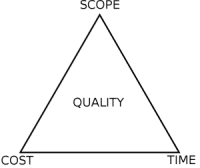The aim with this post is through a scenario to illustrate the gap between the majority and the best when it comes to innovation of high-tech Products.
Setting the scene
Team Beetle and Team Mc Laren are both Product companies doing their own high-tech BtB Product innovation and production in the Renewable Energy market.
As will be evident below, the two companies are very different in many aspects.
Team Beetle - among the majority
For the last several years, Team Beetle has achieved significant success as a Solution Provider to e.g., major OEMs through a focused and strong business strategy. Only a small fraction of Team Beetle’s innovation capacity has been spent on its own product portfolio.
Team Beetle has lately revised its overall business vision and strategy moving its focus to Product innovation with the ambition to become among the best high-tech Product companies in its field founded on a strong Product Culture.
Though some initiatives have been taken on e.g., DevOps teams, the organizational structure and mindset is classic far from having the aspired Product Culture. The spine-reaction in Team Beetle when faced with a challenge is driven by the modus operandi in the Solution Provider part of the business: a Project and its substantial bureaucracy.

Team Mc Laren - among the best

Team Mc Laren was born out of the start-up environment with a strong focus on Product Management and Product Teams. Despite its success and exponential growth, Team Mc Laren has managed to maintain its original start-up traits being extremely customer-focused and having a Minimum Viable Bureaucracy governing its high-tech Product innovation.
The developers are highly skilled developing the solution, once identified during Discovery, meeting the Brands quality expectations.
You’ll not hear Team Mc Laren talk about having business agility, using specific Agile Frameworks or having “Agile Coaches”. They care about their Product Culture.
An internal stakeholder has an input for business improvement on a Product
We’re here assuming a product with a successful Product/Market fit. The Strategic Sourcing function (sourcing production material across the full product portfolio) has identified a new core component when used, will reduce the total production cost by estimated 20+% of the given Product. The caveat is that a radical product design change is needed which in turn demands significant changes in the Advanced Manufacturing configuration.
Team Beetle
The first obstacle met by Strategic Sourcing is finding the right person to talk to. They end-up talking to the VP of Engineering, who happens to be a very busy man. The message from him is
- My department is already fully loaded the next 18 month
- You’ll need to use formula xyz for a change request, and have that change request presented for the central Change Control Board; they meet next time in three weeks
- The PMO is low on Project Managers; you might want also to have a talk with the Head of PMO. He’ll have to adjust the Project Portfolio and move people around
It is very clear where Team Beetle has its focus: On Output, which is no surprise. The ability with a high degree of predictability to deliver Output within the traditional Project Triangle has been the primary measure of success in the Solution Provider business model.

Team Beetle has big road maps stating which features (Output) must be developed and delivered when.
Conclusion
This is what killed by bureaucracy and Output-based Project Thinking looks like. Instead of acting on this strong input, Team Beetle missed the window of opportunity leaving it open for the competitors to exploit.
Not only was the Product opportunity missed; the guys from Strategic Sourcing was left disillusioned and will probably not bother bringing this type of opportunity forward again.
Team Beetle needs a fundamental re-programming of, what success looks like. Being a Solution Provider with a Service Provider Mindset, of course calls for the Output mindset.
In contrast, the Product company will of course need to focus on Outcome.
Team Mc Laren
Strategic Sourcing knows exactly who to address: a specific Product Manager or the Head of Product (the CPO – Chief Product Officer). It is hardwired in the Product Culture DNA that a Product Manager has a deep knowledge of your business including an alignment with his stakeholders.
The Product Manager is excited to learn about this opportunity to further improve the Outcome generated by his product (yes – he feels a strong ownership). He has always a high awareness of the four core Product risks (ref. INSPIRED page 165)
- Value risk – will the customer buy this, or chose to use it?
- Usability risk – can the customer figure out how to use it?
- Feasibility risk – can we build it?
- Business viability risk – does it work for our business?
Based on the input from Strategic Sourcing, the Product Manager concludes that he’ll need the engineers in the Product Team to design and run a quick set of feasibility experiments. Because the Product Manager is driven by a strong Product Culture, he want decisions to be made on facts being conclusions from the experiments.
Team Mc Laren knows where value is created: in the Product Teams. The whole Leadership structure and mindset is optimized for exactly providing the best conditions for the network of Product Teams to thrive.

Conclusion
The engineers saw no major feasibility risks, and the Product Manager agreed with the Product Team to update the existing OKRs and suggest new ones to the Head of Product.
If the change of the core component had influenced the Product Strategy and maybe even the Product Vision, then the Product Manager would have negotiated changes with the Head of Product and Head of Technology.
Team Mc Laren demonstrates what business agility is about.
Wrap-up
Getting and maintaining (despite rapid growth) a strong Product Culture is hard. If your roots are founded in a classic Output-based Project Mindset, your challenge is even harder. Not only do you need to learn fundamentally new ways of working; you also have to unlearn much of what before has been considered best practice.
The good news is that the sooner you (being a company aspiring to become a successful high-tech Product company) get started, the better are your chances to get ahead of competition.

